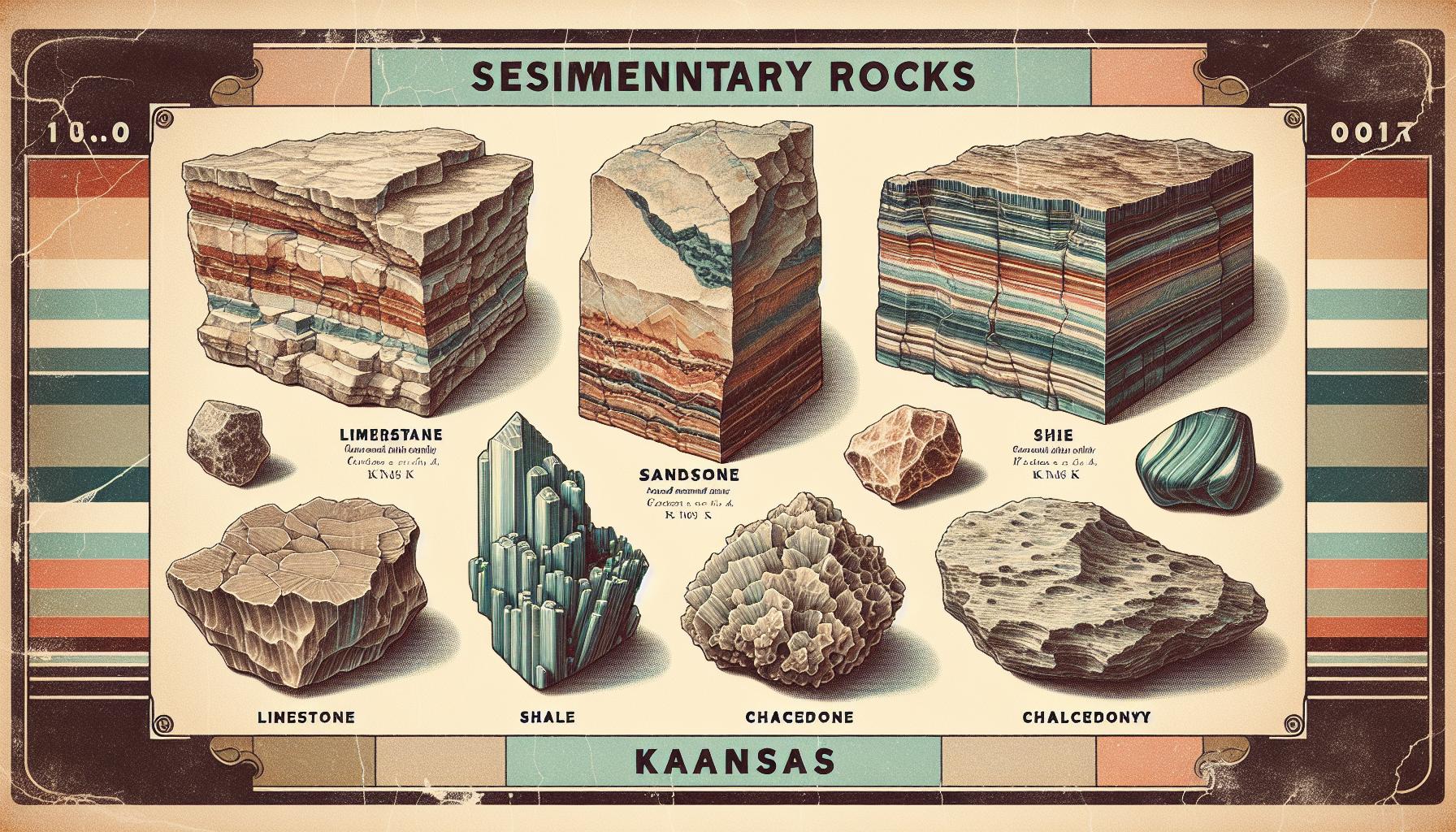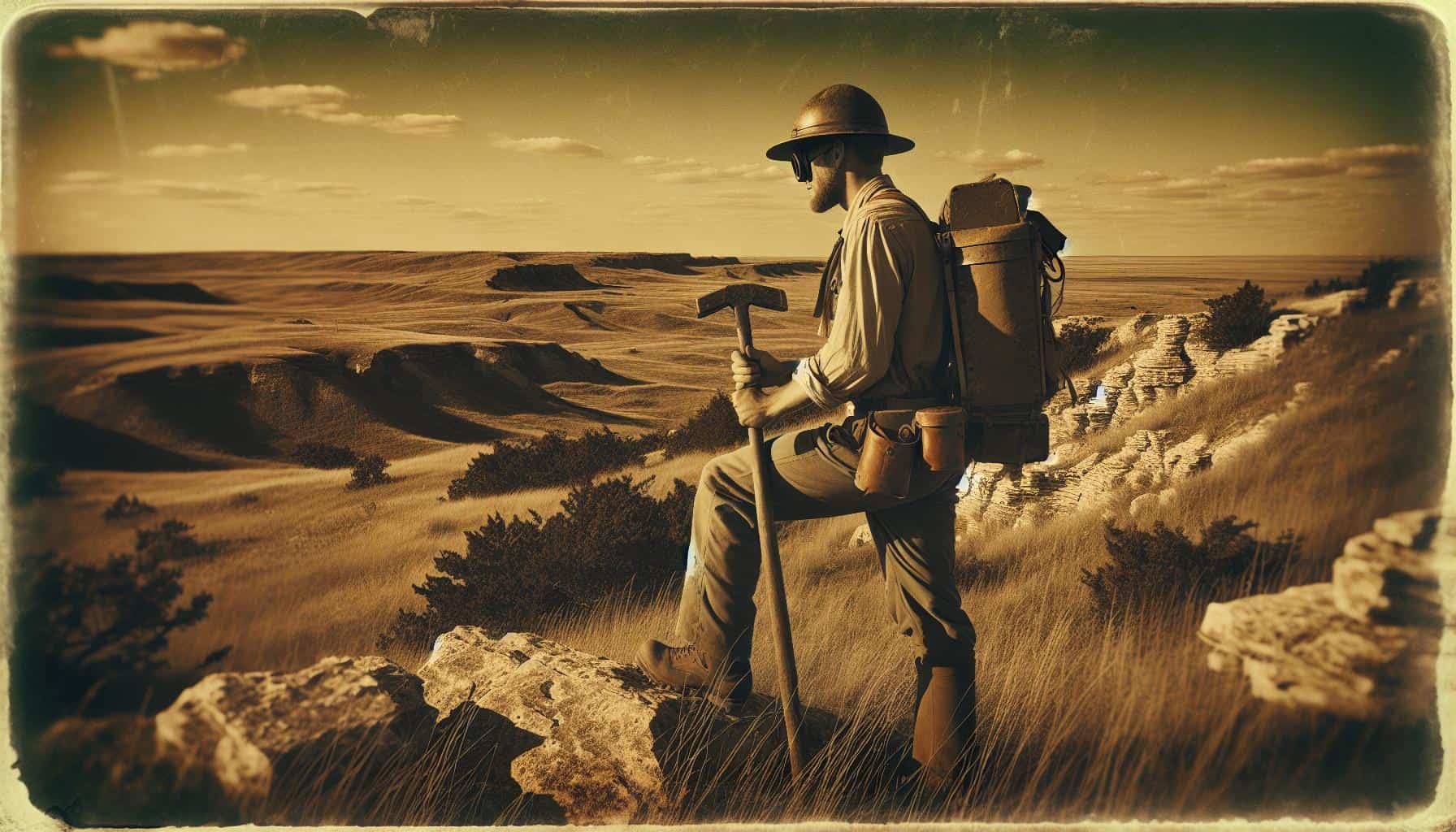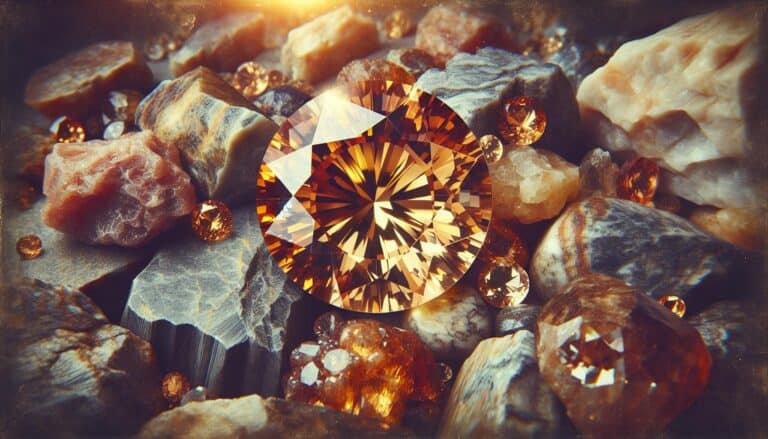Ready to uncover the hidden treasures of Kansas?
You’re in for a treat! The Sunflower State, often overlooked by rockhounds, is brimming with geological wonders just waiting to be discovered. From the rolling Flint Hills to the ancient Smoky Hills, Kansas offers a unique rockhounding experience that’s as rich as its history.
Whether you’re a seasoned collector or just starting out, Kansas’s diverse landscape provides a plethora of opportunities to find some truly remarkable specimens. You’ll be amazed at what you can find: from fossilized remains of prehistoric sea creatures to sparkling minerals and rare crystals.
Let’s dig into the best spots to explore and the treasures you can expect to unearth in the heartland of America.
Kansas, often overlooked by rockhounds, is a hidden gem for geological treasures. Notable locations include Cherokee County for galena and sphalerite, Konza Prairie for geodes, Lincoln County for jasper and calcite, and Gove County for fossilized marine remains. Each site offers unique finds, revealing Kansas’s rich geological history.
Kansas Rockhounding Locations
When you’re ready to begin your rockhounding adventure in Kansas, knowing the right places to search is key. The state is dotted with sites famous for their unique geological formations and hidden gems.
Cherokee County is a hotspot for lead and zinc minerals. Here, you’ll find galena and sphalerite, remnants of a bygone era of extensive mining. The county is accessible for rock hounds eager to dig into history, and you’re likely to leave with a rewarding haul from the old mine tailings.
In the central part of the state, the Konza Prairie reveals its treasure to those who walk its trails—geodes, with their unassuming exterior, holding crystalline secrets within. Hike the area and your eyes might catch the spherical shapes that signal a potential geode nearby.
Heading north, near the town of Lincoln, mineral enthusiasts will be delighted with the opportunities at Lincoln County. Here, rock seekers can unearth a variety of minerals, such as jasper and calcite. You’re encouraged to prospect the area but always abide by local regulations to protect these natural spaces.
For those fascinated by prehistoric times, Gove County is your must-visit destination. Embedded within the chalk beds of the Niobrara Formation, you have the chance to find fossilized fish and other marine life that once swam in the Western Interior Seaway.
Below is a quick reference to clear-cut locations and their associated finds:
| Location | Notable Finds |
|---|---|
| Cherokee County | Galena, Sphalerite |
| Konza Prairie | Geodes |
| Lincoln County | Jasper, Calcite |
| Gove County | Fossilized Marine Remains |
Before setting out, remember to check accessibility and obtain any necessary permissions, as some areas may be on private land or have specific rules for collecting specimens. With the right preparation, your rockhounding journey in Kansas could be as enriching as the earth beneath your feet.
What Gemstones are Found in Kansas?

As you continue your rockhounding adventure in Kansas, you’ll find that the Sunflower State is not just about prairies and farmlands; it’s also a hidden gem for finding actual gemstones. While not as prolific as other states, Kansas offers a modest variety of precious stones that can intrigue any beginner or seasoned rockhound.
One of the most sought-after gemstones in Kansas is amber. This golden-hued fossilized tree resin can occasionally be unearthed in the eastern part of the state. Amber’s warm luster and historic inclusions make it a fascinating find. Collectors often appreciate amber for its organic beauty and connection to the ancient past.
Another gemstone to keep your eyes peeled for is Jett, a form of lignite that’s compacted and can be polished to a high sheen. It’s been used in jewelry making for centuries. In Kansas, bits of this lustrous black stone are sometimes discovered amidst the sedimentary layers of the High Plains region.
For those keen on a challenge, Kansas can sometimes yield small, yet vibrant garnets. These deep red gemstones are often found by sifting through the gravels of streams and rivers, especially where erosion has exposed older rocks. Although garnets in Kansas don’t typically reach large sizes, they can still be a dazzling addition to your collection.
- Amber
- Jett
- Garnets
Remember, proper identification is key. Some gemstones may appear unassuming at first glance and could be easily passed over. It’s always a good idea to take a closer look at any small stones or pebbles that catch your light or show hints of color or translucence. With a little patience and a keen eye, you may unearth some of Kansas’s treasured gems.
What Sedimentary Rocks You Can Find in Kansas?

When exploring Kansas for rocks, you’re likely to come across a variety of sedimentary stones. Limestone is predominant, given the state’s geological history, with vast ancient seas leaving behind thick layers over time. This rock is not only abundant but also valuable for its fossil content, offering a tangible history of sea life that once thrived here.
Sandstone, with its distinctive layers, is another key find in the Sunflower State. Its formation from sand particles solidified over millions of years results in an assortment of colors and patterns, providing a spectrum of options for collectors. You’ll primarily find sandstone formations in the eastern regions, where the sandy beaches of ancient times have solidified into the rocks you see today.
Next up are shale formations, composed of fine-grained sedimentary material. Often overlooked due to their plain appearance, shales can hold surprising fossilized plants or animals. Their subtle stratification can reveal much about the environment of ancient Kansas.
Chances are you’ll also stumble upon chalcedony in your Kansas rockhounding adventures. This microcrystalline variety of quartz has a waxy luster and can be translucent to opaque. Chalcedony nodules are typically found in the western parts of the state, offering a semi-precious gem for those with a discerning eye.
Lastly, don’t miss out on flint or chert. This hard, sedimentary cryptocrystalline form of quartz is known for its use in tools by Native Americans and pioneers. It’s typically gray or brown and can be found in the form of nodules or layers within limestone.
Here’s a quick list of sedimentary rocks you might encounter:
- Limestone
- Sandstone
- Shale
- Chalcedony
- Flint/Chert
Remember, each rock has its story, reflecting the rich geological tapestry of Kansas. Keep your eyes peeled and your identification guides handy; you never know what sedimentary wonders await your discovery.
What Metamorphic Rocks are found in Kansas?
While Kansas isn’t renowned for its abundance of metamorphic rocks, you’ll find that the Sunflower State does offer some interesting finds for those with a keen eye. Unlike sedimentary rocks which are plentiful, metamorphic rocks here are a bit of a rarity due to the geological history of the region. However, there are a few areas where you might stumble upon these transformed stones.
Greenstone, a metamorphosed basalt or gabbro, is one of the metamorphic rocks you can find in Kansas. The presence of greenstone is a treat for rockhounds, hinting at the ancient volcanic activity that once occurred in the state. Another rock worth mentioning is gneiss, though it’s less common. With its distinctive banded pattern, gneiss results from high-grade metamorphism and is a must-grab if you’re lucky enough to find it.
When exploring for metamorphic rocks, your best bets are to check in and around older structures or in stream beds, where erosion may have uncovered these hidden gems. Consider the following sites which have reported metamorphic rock finds:
- Flint Hills region
- Osage County
Take note that proper identification of metamorphic rocks requires an understanding of mineral composition and textural changes, so make sure you have a detailed guidebook or take along someone experienced in rock identification.
In your search, remember to respect property rights and always seek permission before venturing onto private land for rockhounding. Safety should be your priority, so equip yourself with the right gear, including a sturdy pair of gloves, protective eyewear, and a reliable hammer or chisel for gently extracting samples.
What Igneous Rocks can You Find in Kansas?
While you’re exploring the rocky treasures of Kansas, you’ll find that igneous rocks, though not as widespread as sedimentary and metamorphic counterparts, have a presence worth noting. Kimberlites, a type of volcanic rock, are particularly famous in the state for their close association with diamonds. These rocks were formed deep within the Earth’s mantle and were brought to the surface by volcanic activity.
In the northeastern parts of Kansas, you might come across lamproite, another rare volcanic rock. Much like kimberlites, lamproites are known to contain diamonds, although in lesser quantities. Discovering these rocks is a welcoming sign for rockhounders with hopes of finding precious stones.
Additionally, basalt, which is commonly found as a fine-grained igneous rock, can occasionally be encountered in glacial deposits. Although basalt itself is not native to the Kansas environment, these rocks were carried from distant volcanic activity and deposited within the state’s boundaries by glacial movement during the Pleistocene epoch.
Exploring Kansas for igneous rocks also means looking for geodes, which, while not igneous in their entirety, often have an igneous shell. Geodes are spherical stones with a hollow cavity lined with crystals such as quartz or amethyst. Your best bet for finding geodes is in the southeastern areas of the state, especially around the Ozark Plateau, where the conditions for their formation were favorable.
When searching for igneous rocks in Kansas, remember to:
- Seek permission if you’re on private land
- Be aware of state regulations regarding rock collecting
- Always wear proper safety gear
- Use accurate reference materials for identification
Embarking on a rockhounding adventure in search of igneous rocks takes careful planning and a sharp eye. Whether it’s chasing down the elusive sparkle of a diamond in a kimberlite or prying open a geode to reveal its crystal-laden treasure, Kansas offers the unexpected joy of uncovering beauty from beneath its surface.
Panning for Gold in Kansas
Believe it or not, you can pan for gold in the Sunflower State. Kansas is not known for its wealth of gold like some other states, yet patient prospectors can still find some flakes and maybe even small nuggets if they know where to look. Most of the gold in Kansas is thought to be glacial, deposited by melting glaciers eons ago, and thus is primarily located in the northeastern parts of the state.
Start your adventure by visiting public lands or streams that have been historically reported to carry gold. The Kansas River and its tributaries, especially around Junction City, have been popular spots. Keep in mind, since it’s not a commercial activity in Kansas, you’re more likely to enjoy the tranquility of the outdoor experience than to strike it rich.
Gold panning requires perseverance and patience. You’ll need a gold pan and a good supply of water to sift through sediment. Make sure you have a fine screen to separate the gold flakes from larger, non-valuable material. As you swirl the pan, watch for the heavier gold to settle at the bottom—this technique takes practice but can be quite rewarding when you spot that glimmer of gold.
In terms of preparation, arm yourself with knowledge before heading out. Check current land regulations and always ensure that you’re not trespassing on private property. It’s best to obtain explicit permission if you’re unsure about your right to pan in a location. Additionally, consider the environmental impact of your activities and strive to leave no trace.
With the right approach, gold panning in Kansas can be more than just a fun hobby—it’s a way to connect with nature, learn about geology, and perhaps uncover small pieces of hidden treasure. Watch local rockhounding forums for experienced advice and recent success stories to boost your gold hunting expedition.
Rocks and Minerals Found in Kansas
As you delve into rockhounding in Kansas, you’ll discover a variety of rocks and minerals that can be found across this geologically diverse state. Kansas is known for its unique and wide-ranging geological formations, which include sedimentary, igneous, and metamorphic rocks.
In the eastern regions, sedimentary rocks such as limestone, shale, and sandstone dominate the landscape. This is a direct result of ancient seas that once covered the area, leaving behind fossiliferous limestone and shale rich with preserved ancient marine life. Among these, the well-known Post Rock Limestone, used historically for building and fencing, is of particular interest to rock enthusiasts.
Equally compelling are the western Kansas mineral deposits. Here, you can find the renowned Smoky Quartz and fantastic displays of amber-colored calcite. The smoky quartz, ranging in shade from light grey to nearly black, is highly sought after by collectors for its clarity and natural luster.
Moving to central Kansas, you enter a zone known for gypsum and salt—the remnants of prehistoric inland seas. Evaporative processes over the eons have left immense deposits of these minerals. Gypsum can be found in the form of selenite crystals which are clear and flat, displaying a pearl-like luster. Alabaster, a fine-grained variety of gypsum, is also found here.
For those with a keen interest in paleontology, Kansas offers a treasure trove of fossils. Many rockhounds enjoy searching for fossilized remains of ancient sea creatures such as clams, trilobites, and even ancient fishes that swam in the Cretaceous seas that once spanned this area.
Notable minerals and rocks you might come across in Kansas include:
- Jaspers
- Chalcedony
- Fluorite
- Galena (a lead ore)
- Marcasite
Remember, always verify that you’re rockhounding in areas where collection is permitted and respect the local regulations. With these tips in mind, set out on your Kansas rockhounding adventure and embrace the rich geological wonders waiting to be discovered.
Where Can I Find Fossils in Kansas?
Rockhounding for fossils in Kansas can be an exciting adventure, as the state has a rich prehistoric past. Your journey for discovering ancient life starts in the chalk beds of the Niobrara Formation, primarily found in the western part of the state. Gove County and Logan County are particularly notable for fossils from the Late Cretaceous period.
In these areas, you’ll have the chance to uncover fossils of swimming reptiles like mosasaurs and plesiosaurs, as well as ancient flying reptiles known as pterosaurs. Additionally, the fossilized remains of fish and marine invertebrates like clams and ammonites are commonly found here.
Moving eastward, the Keystone Gallery located near Scott City is a private museum that is also a known hotspot for fossil hunters. They offer fossil-hunting tours where you could unearth shark teeth and other remnants of marine life. It’s a good practice to call first to ensure they are open and offering tours during your visit.
The celebrated Fossil Station Museum in Russell, Kansas, is a must-visit for any fossil enthusiast. While you may not be digging here, you’ll be treated to a vast display of local finds and gain better insight into what sorts of fossils you can discover in the area.
- Check out Monument Rocks and Castle Rock for public access to fossil hunting grounds.
- Don’t forget Mushroom Rock State Park and Kanopolis State Park where even beginners have been known to find fascinating fossil specimens.
Remember that fossil hunting often requires permission if you’re venturing onto private land, and some sites may have restrictions to protect natural heritage. Always inquire about permits and obey all rules and regulations when searching for these ancient treasures. Your respect for these spaces will ensure they remain available for future generations of fossil hunters.
Kansas Rockhounding Laws & Regulations
When you’re rockhounding in Kansas, it’s imperative to stay informed about the local laws and regulations that govern the collection of rocks, minerals, and fossils. Understanding these rules ensures that you preserve the natural habitats and respect the rights of property owners.
Land Ownership and Permissions
First and foremost, always check land ownership. Public land may have different guidelines compared to private property. On public lands, such as state parks and national forests, rockhounding is usually allowed, but there may be limitations on the amount and type of materials you can collect. For instance, in state parks you’re often limited to whatever you can carry by hand, and mechanical tools are prohibited. Always verify with park officials before collecting.
Conversely, private land requires the owner’s consent. Never trespass or take rocks without permission. Trespassing can lead to hefty fines or even arrest. Additionally, some historical sites are protected, meaning that collecting any materials, even rocks and fossils, is unlawful.
Fossil and Artifact Protection
Special attention must be paid to fossils and artifacts. Kansas law protects vertebrate fossils and articrafts. You need to secure a permit for collecting vertebrate fossils, as they are considered state property. Invertebrate and plant fossils are usually fair game for casual collectors, but be sure to stay updated on any changes to these regulations.
| Protected Items | Collection Status |
|---|---|
| Vertebrate Fossils | Permit Required |
| Invertebrate and Plant Fossils | Generally Allowed |
| Artifacts | Protected by Law |
Be mindful that these items have important scientific and educational value. Remove them responsibly, if permitted, and consider contributing to local museums or scientific institutions.
Know the Rules
Before you head out, it’s smart to familiarize yourself with the Kansas Department of Wildlife, Parks and Tourism regulations. They offer detailed information on what items are collectible and under what circumstances. Remember that laws can change, and it’s your responsibility to stay informed to ensure that your rockhounding adventure is both enjoyable and legal. Always carry a good field guide that includes legal guidelines, or keep a digital copy on your phone for quick reference.
Rockhounding Tips for Beginners in Kansas
Gearing Up: Essential Tools for Rockhounding
Before you head out on your rockhounding adventure, make sure you’ve got the right gear. Your toolkit should include:
- Rock hammer or geologist’s pick: This is crucial for prying out specimens.
- Safety goggles: Always protect your eyes from flying debris.
- Sturdy gloves: They’ll save your hands from cuts and bruises.
- Chisels and screwdrivers: These help in extracting crystals carefully.
- Backpack or bucket: You’ll need something to carry your finds.
- Field guide: To identify rocks, minerals, and fossils.
- First-aid kit: Just in case you encounter minor injuries.
- GPS or a detailed map: To navigate unfamiliar terrain without getting lost.
Ensure your supplies are comfortable to carry for long periods, especially since some of the best rockhounding sites might be off the beaten path.
Safety Tips While Rockhounding
Rockhounding should be an enjoyable and safe hobby. Keep these tips in mind to ensure your safety:
- Always let someone know where you’ll be: If you’re headed to remote locations, it’s crucial someone is aware in case of emergencies.
- Stay hydrated and bring snacks: Kansas weather can be unpredictable; prepare for extremes.
- Dress appropriately: Wear long sleeves, hats, and sunscreen to protect against the sun.
- Watch where you step: Loose rocks and uneven terrain are common.
- Be wary of wildlife: Kansas is home to a variety of wildlife; know how to deal with any encounters peacefully and safely.
- Respect the elements: Check the weather forecast and avoid rockhounding during adverse weather conditions.
Legal Guidelines for Rockhounding Enthusiasts
While Kansas is a great state for rockhounding, you must stay informed about legalities:
- Property Permissions: Always seek permission before entering private land.
- Collection Limits: Familiarize yourself with limits on the quantity and type of specimens you can remove.
- Protected Areas: Be aware of any state parks or historical sites where collecting is prohibited.
- Permit Requirements: For vertebrate fossils, a permit is usually required as they are state property.
Understanding and adhering to these laws will not only keep you out of trouble but will help preserve the sites for future rockhounds. Keep an updated list of local regulations handy, and remember that responsibility and ethical practices are the marks of a true enthusiast.
Conclusion: Kansas Rockhounding Guide & Map
Armed with the right gear, a sense of adventure, and a respect for the land and its laws, you’re ready to tackle the exciting world of rockhounding in Kansas.
Remember to prioritize safety, legality, and environmental responsibility on your quest. Whether you’re searching for that perfect jasper specimen or hoping to uncover hidden geodes, Kansas’s diverse terrain is a treasure trove awaiting your discovery.
Get out there, explore responsibly, and who knows what natural wonders you’ll find!







